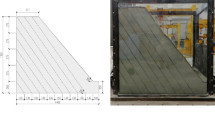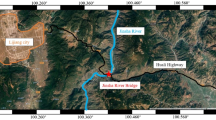Abstract
A large-scale shaking table test was performed to study the dynamic response of slopes parallel to geological bedding (bedding slopes) and slopes that cross-cut geological bedding (counter-bedding slopes). The test results show that the acceleration amplification coefficients increase with increasing elevation and, when the input earthquake amplitude is greater than 0.3 g, both bedding and counter-bedding slopes begin to show nonlinear dynamic response characteristics. With increasing elevation, the displacement of the bedding slope surface increases greatly. Conversely, the displacement of the counter-bedding slope surface increases first and then decreases; the slope develops a bulge at the relative elevation of 0.85. The displacement of the bedding slope surface is greater than that of the counter-bedding slope. The counter-bedding slope is more seismically stable compared with the bedding slope. Based on the Hilbert–Huang transform and marginal spectrum theories, the processes that develop dynamic damage of the bedding and counter-bedding slopes are identified. It is shown that the dynamic failure mode of the bedding slope is mainly represented by vertical tensile cracks at the rear of the slope, bedding slide of the strata along the weak intercalation, and rock collapse from the slope crest. However, the dynamic failure mode of the counter-bedding slope is mainly represented by staggered horizontal and vertical fissures, extrusion of the weak intercalation, and breakage at the slope crest.


















Similar content being viewed by others
References
Aydan Ö, Ohta Y, Geniş M, Tokashiki N, Ohkubo K (2010) Response and stability of underground structures in rock mass during earthquakes. Rock Mech Rock Eng 43:857–875
Barbero M, Barla G (2010) Stability analysis of a rock column in seismic conditions. Rock Mech Rock Eng 43:845–855
Bommer JJ, Acevedo AB (2004) The use of real earthquake accelerograms as input to dynamic analysis. J Earthquake Eng 8(Special Issue 1):43–91
Brand L (1957) The Pi theorem of dimensional analysis. Arch Ration Mech Anal 1:35–45
Cao H, Yang H, Friswell MI, Bai SL (2004) The analysis of earthquake waves based on nonlinear responses of RC structures. In: Proceedings of the 7th biennial conference on engineering systems design and analysis, Manchester, UK, July 2004, no. ESDA2004-58253
Chen ZL, Xu Q, Hu X (2013) Study on dynamic response of the “Dualistic” structure rock slope with seismic wave theory. J Mt Sci 10(6):996–1007
Clough RW, Pirtz D (1956) Earthquake resistance of rock-fill dams. J Soil Mech Found Div 82(2):1–26
Curtis WD, Logan JD, Parker WA (1982) Dimensional analysis and the Pi theorem. Lin Algebra Appl 47:117–126
Dai FC, Xu C, Yao X, Xu L, Tu XB, Gong QM (2011) Spatial distribution of landslides triggered by the 2008 Ms 8.0 Wenchuan earthquake, China. J Asian Earth Sci 40:883–895
Huang RQ (2012) Mechanisms of large-scale landslides in China. Bull Eng Geol Environ 71:161–170
Huang RQ, Li WL (2009a) Development and distribution of geohazards triggered by the 5.12 Wenchuan Earthquake in China. Sci China Ser E Technol Sci 52:810–819
Huang RQ, Li WL (2009b) Analysis of the geo-hazards triggered by the 12 May 2008 Wenchuan Earthquake, China. Bull Eng Geol Environ 68:363–371
Huang QX, Wang JL (2011) Study of the deformation characteristics of an anti-dip slope with soft internal layers. China Civil Eng J 44(5):109–114 (in Chinese)
Huang NE, Shen Z, Long SR, Wu MC, Shih HH, Zheng Q, Yen NC, Tung CC, Liu HH (1998) The empirical mode decomposition and the Hilbert spectrum for nonlinear and non-stationary time series analysis. Proc R Soc Lond Ser A 454:903–995
Huang RQ, Li G, Ju NP (2013a) Shaking table test on strong earthquake response of stratified rock slopes. Chin J Rock Mech Eng 32(5):865–875 (in Chinese)
Huang RQ, Zhao JJ, Ju NP, Li G, Lee ML, Li YR (2013b) Analysis of an anti-dip landslide triggered by the 2008 Wenchuan earthquake in China. Nat Hazards 68:1021–1039
Krinitzsky EL, Chang FK (1977) Specifying peak motions for design earthquakes. State-of-the-art for assessing earthquake hazards in the United States, Report 7, Miscellaneous Paper S-73-1. US Army Corps of Engineers, Vicksburg, Mississippi
Latha GM, Garaga A (2010) Seismic stability analysis of a Himalayan rock slope. Rock Mech Rock Eng 43:831–843
Li CS, Lam SSE, Zhang MZ, Wong YL (2006) Shaking table test of a 1:20 scale high-rise building with a transfer plate system. J Struct Eng 132:1732–1744
Lin ML, Wang KL (2006) Seismic slope behavior in a large-scale shaking table model test. Eng Geol 86:118–133
Ling HI, Mohri Y, Leshchinsky D, Burke C, Matsushima K, Liu HB (2005) Large-scale shaking table tests on modular-block reinforced soil retaining walls. J Geotech Geoenviron Eng 131:465–476
Liu HX, Xu Q, Li YR, Fan XM (2013) Response of high-strength rock slope to seismic waves in a shaking table test. Bull Seismol Soc Am 103:3012–3025
Liu HX, Xu Q, Li YR (2014) Effect of lithology and structure on seismic response of steep slope in a shaking table test. J Mt Sci 11(2):371–383
Matsuo O, Tsutsumi T, Yokoyama K, Saito Y (1998) Shaking table tests and analyses of geosynthetic-reinforced soil retaining walls. Geosynth Int 5:97–126
Meymand PJ (1998) Shaking table scale model tests of nonlinear soil-pile-superstructure interaction in soft clay. Ph.D. dissertation, University of California, Berkeley
Seismosoft (2002) SeismoSignal. Pavia, Italy
Wartman J, Seed RB, Bray JD (2005) Shaking table modeling of seismically induced deformations in slopes. J Geotech Geoenviron Eng 131:610–622
Wasowski J, Keefer DK, Lee CT (2011) Toward the next generation of research on earthquake-induced landslides: current issues and future challenges. Eng Geol 122:1–8
Xu BT, Yan CH (2014) An experimental study of the mechanical behavior of a weak intercalated layer. Rock Mech Rock Eng 47:791–798
Yang GX, Wu FQ, Dong JY, Qi SW (2012) Study of dynamic response characters and failure mechanism of rock slope under earthquake. Chin J Rock Mech Eng 31(4):696–702 (in Chinese)
Yang TH, Xu T, Liu HY, Zhang CM, Wang SY, Rui YQ, Shen L (2014) Rheological characteristics of weak rock mass and effects on the long-term stability of slopes. Rock Mech Rock Eng 47:2253–2263
Yeh CH, Wen YK (1990) Modeling of nonstationary ground motion and analysis of inelastic structural response. Struct Saf 8:281–298
Acknowledgments
This research is financially supported by the National Basic Research Program (973 Program) of the Ministry of Science and Technology of the People’s Republic of China (2011CB013605) and the Research Program of the Ministry of Transport of the People’s Republic of China (2013318800020). The authors are grateful to the unnamed reviewers for their valuable comments on the early version of the manuscript.
Author information
Authors and Affiliations
Corresponding author
Additional information
Data and resources
The definition and application of MATLAB’s function tfestimate can be searched using http://www.mathworks.cn/cn/help/signal/ref/tfestimate.html.
Rights and permissions
About this article
Cite this article
Fan, G., Zhang, J., Wu, J. et al. Dynamic Response and Dynamic Failure Mode of a Weak Intercalated Rock Slope Using a Shaking Table. Rock Mech Rock Eng 49, 3243–3256 (2016). https://doi.org/10.1007/s00603-016-0971-7
Received:
Accepted:
Published:
Issue Date:
DOI: https://doi.org/10.1007/s00603-016-0971-7




